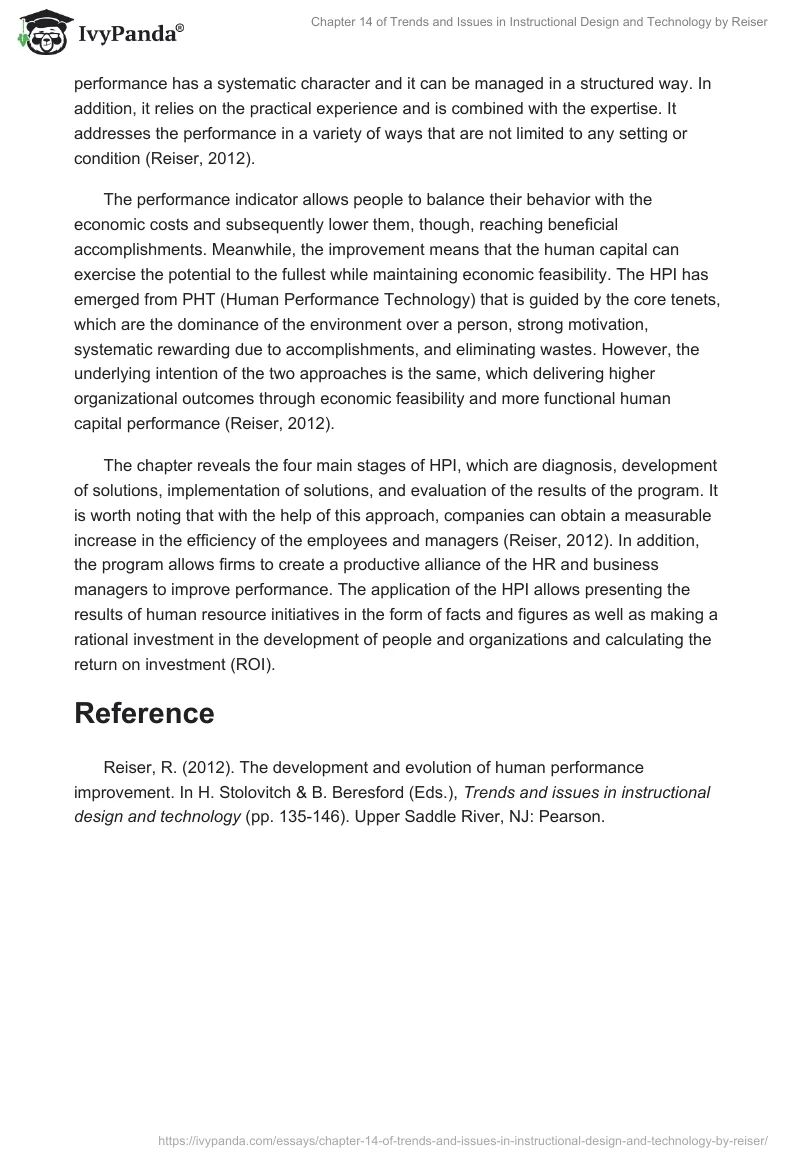The chapter on the Human Performance Improvement dwells upon the means that can be applied in organizations striving for the improvement and enhancement of their internal and external operations. The writing explains the importance of this tool for those companies reaching higher complexity in their organizational relationships. The authors stress out that the application of the tool is a necessity for contemporary companies and provide arguments proving the functionality of the approach.
Human Performance Improvement (HPI) is the reflection of the increasing demand for systemic thinking, which implies versatile types of interventions (Reiser, 2012). HPI has presented a different perspective on the business outcomes and it views them as the final result of various associated elements. According to the chapter, the approach enables producing complex products because the current setting encourages managers to operate rapidly in diversified settings; consequently, simple solutions are no longer applicable and do not respond to the managerial requirements (Reiser, 2012).
The increased organizational complexity promotes such an environment, in which the leadership should be able to exercise agility. Moreover, the introduction of HPI ensures that such specialists like performance consultants can do multi-tasking and collaborate with client groups efficiently.
Further on, the authors underline that HPI has a focus on the company’s performance and contributes to its enhancement. With the help of the approach, managers are able to account for different environmental aspects simultaneously (Reiser, 2012). Thus, HPI influences the way the employees perform and reach higher organizational outcomes through alternative methods of obtaining results. HPI ensures that the organization is capable of making an analysis of the existing gaps and implements such practices that are beneficial and economically feasible for the firm.
In terms of the human indicator, HPI is focused on the measures taken by people and the outcomes they get afterward. The professional field reveals that human performance has a systematic character and it can be managed in a structured way. In addition, it relies on the practical experience and is combined with the expertise. It addresses the performance in a variety of ways that are not limited to any setting or condition (Reiser, 2012).
The performance indicator allows people to balance their behavior with the economic costs and subsequently lower them, though, reaching beneficial accomplishments. Meanwhile, the improvement means that the human capital can exercise the potential to the fullest while maintaining economic feasibility. The HPI has emerged from PHT (Human Performance Technology) that is guided by the core tenets, which are the dominance of the environment over a person, strong motivation, systematic rewarding due to accomplishments, and eliminating wastes. However, the underlying intention of the two approaches is the same, which delivering higher organizational outcomes through economic feasibility and more functional human capital performance (Reiser, 2012).
The chapter reveals the four main stages of HPI, which are diagnosis, development of solutions, implementation of solutions, and evaluation of the results of the program. It is worth noting that with the help of this approach, companies can obtain a measurable increase in the efficiency of the employees and managers (Reiser, 2012). In addition, the program allows firms to create a productive alliance of the HR and business managers to improve performance. The application of the HPI allows presenting the results of human resource initiatives in the form of facts and figures as well as making a rational investment in the development of people and organizations and calculating the return on investment (ROI).
Reference
Reiser, R. (2012). The development and evolution of human performance improvement. In H. Stolovitch & B. Beresford (Eds.), Trends and issues in instructional design and technology (pp. 135-146). Upper Saddle River, NJ: Pearson.


